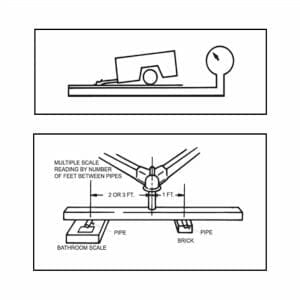Safe Trailer Towing Guide
IMPORTANT INFORMATION ON TOWING
TOWING EQUIPMENT OWNERS: Make sure all operators of your equipment read and understand this information before towing. Save for reference. This will help you properly select, use and maintain your towing equipment. Refer to owner’s manuals for your tow vehicle, trailer, and other parts of your towing system. Learn the capabilities and limitations of each part. GROSS TRAILER WEIGHT and TONGUE WEIGHT are two of the most important items to consider. THESE WEIGHTS MUST NEVER EXCEED THE LOWEST RATING OF ANY PART OF YOUR TOWING SYSTEM.
- GROSS TRAILER WEIGHT: The weight of the trailer plus all cargo. Measure gross trailer weight by putting the fully loaded trailer on a vehicle scale.
- TONGUE WEIGHT: The downward force exerted on the ball by the trailer coupler. Measure tongue weight with the fully loaded trailer on a level surface. The coupler must be at its normal towing height. Use a commercial scale or a bathroom scale. Set up the bathroom scale as shown for heavy tongue weights.
YOUR TOWING EQUIPMENT
TRAILER HITCHES, RECEIVERS, AND BALL MOUNTS Select these products by their gross trailer weight and tongue weight ratings. Match the products according to the anticipated use. Use only those products designed for your vehicle.
HITCH BALLS
Select by gross trailer weight rating, mounting platform thickness and hole size, and coupler socket size. Do not mix one class of hitch ball with another class of coupler. Platform must be at least 3/8 inch thick. Hole must not exceed threaded shank diameter by more than 1/16 inch. Use lock washer. Tighten per instructions. When tightened, shank must protrude beyond bottom of nut. Gross trailer weight rating and ball diameter are marked on hitch balls.
TRAILER COUPLERS
The coupler socket should be smooth, clean, and lightly lubricated. Tighten or adjust per coupler manufacturer’s instructions. Use proper class type.
SAFETY CHAINS
Connect safety chains properly EVERY TIME YOU TOW. Cross chains under coupler. This is done to cradle the trailer tongue in the event the ball and coupler separate. Attach securely to the hitch or tow vehicle so they can’t bounce loose. Leave only enough slack to permit full turning. Too much slack may prevent chains from maintaining control if other connections separate. Don’t let chains drag on the road to avoid chain degradation.
TRAILER LIGHTS, TURN SIGNALS, ELECTRIC BRAKES, AND BREAK AWAY SWITCH CONNECTIONS
Make these safety-critical connections EVERY TIME YOU TOW, no matter how short the trip. Check operation, including electric brake manual control, before getting on the road.
SAFE TOWING TIPS NO PASSENGERS IN TRAILERS!
Never allow people in trailers while towing, under any circumstances.
SWAY CONTROLS
Sway controls can lesson the effects of sudden maneuvers, wind gusts, and buffeting caused by other vehicles. We recommend them for trailers with large surface areas, such as travel trailers. Adjustable friction models can help control trailers with low tongue weight. Recommended tongue weight is 10% of gross trailer weight.
OTHER USEFUL EQUIPMENT
AIR SPRINGS, AIR SHOCKS, or HELPER SPRINGS are useful for some hitch applications. A TRANSMISSION COOLER may be for heavy towing. Many states require TOWING MIRRORS on both sides.
TIRE INFLATION
Check often. Follow tow vehicle and trailer manufacturers’ recommendations. Improper tire inflation can cause uncontrollable trailer sway.
CHECK YOUR EQUIPMENT / REPLACE WORN PARTS
Check ball, coupler, chains, retaining pins and clips, and all other connectors EVERY TIME YOU TOW. Re-check at fuel and rest stops.
TRAILER LOADING
Proper loading helps prevent sway. Place heavy object on the floor ahead of the axle. Balance the load side-to-side. Secure it to prevent shifting. Tongue weight should be 10-15 percent of gross weight for most trailers. Too low a percentage of tongue weight can cause sway. NEVER load the trailer rear-heavy. LOAD THE TRAILER HEAVIER IN FRONT.
DRIVING
The additional weight of a trailer affects acceleration, braking and handling. Allow extra time for passing, stopping, and changing lanes. Severe bumps can damage your towing vehicle, hitch, and trailer. Drive slowly on rough roads. STOP AND MAKE A THOROUGH
INSPECTION IF ANY PART OF YOUR TOWING SYSTEM STRIKES THE ROAD. CORRECT ANY PROBLEMS AND REPLACE ANY DAMAGED PARTS BEFORE RESUMING TRAVEL CHECK FOR EXCESSIVE SWAY AND ELIMINATE IT
Excessive sway can lead to loss of control. Sway motion should settle out quickly. Sway tends to increase on a downgrade. Starting slowly, increase speed in gradual steps. If sway occurs, adjust your trailer load and equipment. Repeat until the trailer is stable at highway speed. Do this whenever your trailer loading changes.
IF TRAILER SUDDENLY STARTS TO SWAY
Turbulence from another vehicle, a wind gust, or a downgrade can cause sudden sway. So can a shift of the trailer’s load or a trailer tire blowout. IF THE TRAILER SWAYS, IT IS THE DRIVER’S RESPONSIBILITY TO ASSESS THE SITUATION AND TAKE APPROPRIATE ACTION. Below are suggestions that may apply, depending on conditions:
DO
- Reduce your speed gradually
- Hold the steering wheel as steady as possible
- If your trailer has electric brakes, apply the trailer brakes alone, without using the tow vehicle’s brakes
Don’t
- Don’t hit your brake pedal hard unless absolutely necessary. A “jackknife” can result
- Don’t try to steer out of the sway condition. Sudden or violent steering can make it worse
- Don’t speed up. Sway increases as you go faster
- Don’t continue towing a trailer that tends to sway. You may lose control during an emergency maneuver or if the conditions listed above occur
DANGER
DO NOT MODIFY PRODUCT. TOWING VEHICLE MUST BE IN GOOD CONDITION. USE ONLY FOR TRAILER TOWING AND/OR ATTACHMENT OF CEQUENT PERFORMANCE PRODUCTS INC. ACCESSORIES. DO NOT EXTEND ORIGINAL STRUCTURE. DO NOT TOW ONE TRAILER BEHIND ANOTHER, WHICH MAY CAUSE LOSS OF CONTROL. FAILURE TO HEED WARNINGS AND FOLLOW INSTRUCTIONS MAY RESULT IN SERIOUS PERSONAL INJURY OR DEATH, VEHICLE CRASH, AND/OR PROPERTY DAMAGE.


